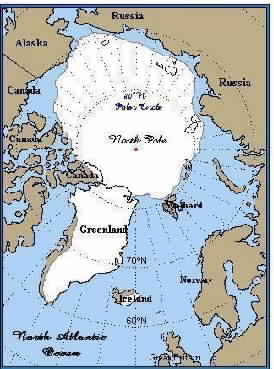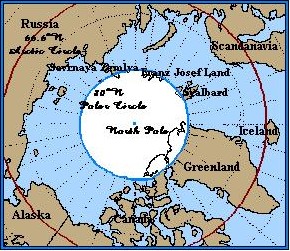 |
 |
 |
|
|
|
 |
 |
 |
| THE POLAR ICE PACK. Map showing the approximate size and location of the permanent polar ice pack. Note, however, that the ice pack tends to expand in winter to touch most of the land areas bordering the Arctic Ocean and to recede during the summer months. Additionally, this amount can vary significantly from year to year. |
| All indications point to a melting and shrinking of the polar ice pack. Long-term effects, however, are speculative. |
 |
|
 |
 |
 |
 |
|
|
|
 |
 |
 |
| The above map indicates the ARCTIC CIRCLE (red) at 66.5�N and the POLAR CIRCLE (blue) at 80�N. The Arctic Circle is a fixed point on the earth's surface, the point at and above which, due to the curvature of the earth, there is at least one day per year of total light. The Polar Circle, on the other hand, is a more or less arbitrary point used to designate the area around the north geographic pole at 90N. |
| A distinction should be made between the North Geographic Pole or TRUE NORTH, and MAGNETIC NORTH or the magnetic north pole. Magnetic North, to which magnetic compasses point, is a mineral deposit in the High Canadian Arctic and is constantly shifting its location. True North is a fixed point at the center of the vast Arctic Ocean or polar sea. Since the polar ice pack is constantly in motion moved by wind and currents, there is no permanent means to mark the location of the north geographic pole. (See Part IV, Magnetic North - the wandering pole). |
| As can be seen from the map, a great deal of land area lies to the north of the Arctic Circle, including parts of northern Alaska, the high Canadian Arctic, most of Greenland (Denmark), northernmost Iceland, parts of Scandinavia and the Russian Arctic. However, the only land areas lying within the Polar Circle are northernmost Ellesmere and Axel Heiberg Islands (Canada), northern Greenland, northernmost Svalbard (Norway), Franz Josef Land (Russia), and Severnaya Zemelya (Russia). |
| The north polar region consists primarily of water, the Arctic Ocean, surrounded by land. By contrast, the south polar region at the opposite end of the earth, consists of land, the Antarctic continent, surrounded by water, the Southern Ocean. |
 |
|



